Amid the recent muscle-flexing in the disputed South China Sea, one maritime drill went largely unnoticed that could be an important harbinger of China’s strategic thinking, and how its forces could project power across heavily contested waters.
It involved the People’s Liberation Army Marine Corps — an arm of the Chinese military that is growing fast as the PLA develops expeditionary forces that can operate further from China’s shores.
The strength of the Marine Corps, or PLANMC, has nearly tripled over the past three years to 35,000 troops, according to a report prepared by Jane’s for the U.S.-China Economic and Security Review Commission. The corps has also become a more visible presence in the South China Sea.
On May 5, the PLANMC undertook an anti-piracy exercise near the Paracel Islands that showed off its capabilities to China’s neighbors at a time of rising tensions in the region. The exercise simulated covert, amphibious assaults by the PLANMC with fast-moving speedboats and naval aviation aircraft, integrating the corps’ operations with the People’s Liberation Army Navy.
The corps is expected to feature in another military exercise planned in the South China Sea in August. This time, they will be simulating an island seizure operation, Kyodo News reported this week, citing anonymous Chinese sources. It is part of a two-and-a-half-month-long series of drills involving the army, navy, and the PLANMC that began this Thursday off China’s northern coast.
China’s state media has not confirmed such an island-seizing exercise would take place, but a Global Times article published Wednesday hinted that such an exercise would be warranted and designed to simulate a takeover of Taiwan and its outlying islands in the event of a “secession.” Taiwan is a self-governing democracy that Beijing regards as part of China.
Taiwan said Wednesday it would be monitoring the movement of China’s military. Other claimants in the South China Sea — Brunei, Malaysia, the Philippines and Vietnam – are also likely to eye any such maneuvers by Chinese amphibious forces with some concern.
Andrew Scobell, the Bren Chair in Non-Western Strategic Thought at Marine Corps University, said the PLANMC is meant to be the “nucleus” for China’s armed forces as they operate further afield. “The PLA is intent on improving its expeditionary capabilities and the Marines are considered a key — if not the core — component of this expeditionary force.” he said.
“The South China Sea is an obvious and convenient training ground for Chinese marines,” Scobell said, although he added that he did not know whether there were plans for a permanent PLANMC presence there.
He said even if there were a permanent presence, the corps would likely stay in the background as China’s military already does during confrontations with other countries in the region – leaving that kind of activity to the China Coast Guard or maritime militia.
He said that for China’s military planners, the PLANMC is a high priority because of their amphibious capabilities. “The Marines are supposed to be a rapid response force,” Scobell said.
But he added that they have been primarily focused on non-combat operations in recent years, especially anti-piracy missions.
Experts say there’s certainly a need for anti-piracy capabilities in the seas of Asia.
The inter-governmental information-sharing group based on the Regional Cooperation Agreement on Combating Piracy and Armed Robbery against Ships in Asia, or ReCAAP, says in its latest quarterly report that there’s been a sharp increase in armed robberies at sea in Southeast Asia.
But most of the lawlessness was in the Straits of Malacca or in the Sulu Sea. There were very few incidents in the South China Sea during 2019.
“The Paracel Islands is not really an area where we find piracy,” said Lydelle Joubert, an expert on global piracy and counter-piracy efforts with the nonprofit group, Stable Seas.
She was referring to the islands in the northern half of the South China Sea near where the PLANMC’s anti-piracy drill took place – disputed between Vietnam, the Philippines, and Taiwan. The Paracels were placed under ‘Xisha District’ in a controversial move by China in April to assert administrative control over the disputed features – along with the Pratas Islands currently occupied by Taiwan.
“We do get conflict between fishing vessels from countries and the Chinese Coast Guard, but you can’t classify that as piracy,” she said.
China does contribute financially to regional information sharing centers focused on piracy in the region. But Jay Benson, also with Stable Seas, said virtually all of China’s anti-piracy efforts at sea were concentrated in the Gulf of Aden off the coast of east Africa. There are no recorded joint patrols aimed at anti-piracy between China and Southeast Asian states, aside from joint patrols China has undertaken up the Mekong River.
Which all serves to fuel skepticism about whether the PLANMC May 5 drill was motivated by Beijing’s concern about piracy in the South China Sea, or to send a message to the other claimants.
According to a press release by the official news outlet of the PLA, the drill focused on “improving the ability to respond to air and sea conditions,” and escorting Navy ships as they moved through contested areas.
The drill coincided with signs that China has stepped up its deployment of expeditionary capabilities to its islands and bases in the South China Sea. Repeat sightings of military aircraft prompted Jane’s to report this week that China’s naval aviation force may be rotating deployments through Fiery Cross Reef, its main base in the Spratly Islands.
 Eurasia Press & News
Eurasia Press & News


